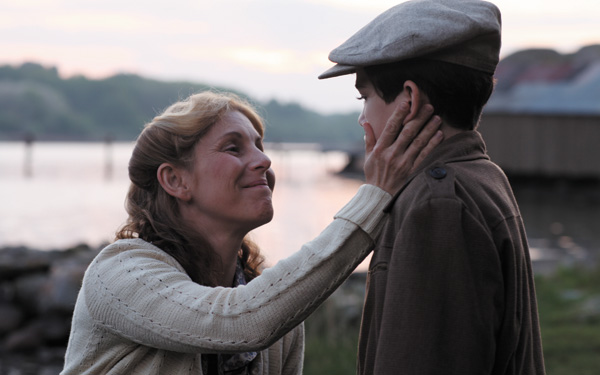Visually lush, moving tale of Jews in WWII-era Sweden
Published October 24, 2012
The award winning, gorgeously photographed “Simon and the Oaks” uses the story of two boys growing up in war-time Sweden to explore issues of identity, humanity and free-will.
In 1939, Simon Larsson (Jonatan S. Wachter) is the only child of a rural class Swedish couple but the solitary boy does not seem to fit in with his working class parents. While Simon’s woodworker father, Erik (Stefan Godicke), tries to draw the boy out by teaching him to box, Simon prefers to spend his time reading and daydreaming in the tree house he build in a huge oak on the rocky seashore, telling his parents the tree is his only friend.
When Simon wants to attend a private school in town, his father is reluctant, worried the boy will become “stuck up.” But his father is eventually persuaded by Simon’s kind-hearted mother Karin (Helen Sjoholm), who hopes there her son will find a friend.
He finds one in Isak Lentov (Karl Martin Eriksson), when Simon stands up for the boy who is being bullied for being Jewish. Simon is amazed to discover that Isak’s father runs a book shop and that his parents, Ruben (Jan Josef Liefers) and Olga (Lena Nylen) are wealthy, cultured refugees from Berlin. As war sweeps across Europe and the Swedish government shows a willingness to work with the Nazis, the two families become close and even merge as Simon’s parents take in Isak when his mother is hospitalized.
“Simon and the Oaks” is based on a best-selling novel of the same name, although the title might be better translated as “Simon and the Oak,” as it is one large oak that plays a role in their lives. The film follows the boys as they grow up and through the post-war era to 1952. We know from the start that there is a secret about dark-haired Simon and his blonde parents but the exact nature of that secret is revealed slowly, as the two families merge and each boy finds a kinship with the other’s father.
Director Lisa Ohlin had long admired the book and was drawn to it in part because of parallels to her own family. Her mother had fled Berlin for New York in 1939 and grappled with survivor’s guilt. When her mother died when Ohlin was five, she went to live with her father in Sweden, where she felt out of place among the blond haired, blue-eyed population. Returning to New York, she reconnected with her mother’s family and discovered her Jewish heritage.
The film has won numerous awards, and is likely headed for more, especially given its stunningly beautiful photography. The images in “Simon and the Oaks” are often lovely but also suffused with a deep meaning as well. As young Simon reads an adventure book set in Egypt in his oak tree, he looks up through the fluttering leaves at a sky of puffy clouds, which transform into the shape of camels, a visual sequence that perfectly captures to wonder of childhood imagination. The imagery is just as lyrical and spot-on throughout the film.
Bill Skargard, the son of the renowned Swedish actor Stellan Skargard, plays the grown Simon, garnering praise for his performance. The acting is excellent throughout, particularly Jan Josef Leifers as Isak’s father Ruben, who takes a fatherly interest in the intellectually gifted Simon. The characters are well-drawn and the story unfolds in unexpected ways, keeping us involved throughout, as it explores questions of identity and personal choices.
















